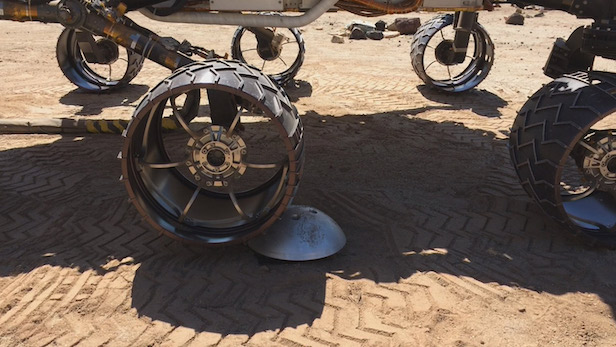NASA’s new algorithm to conserve Curiosity’s wheels
The rough terrain of the Red Planet has produced problems for the Mars rover, but a new algorithm can now help reduce the effect

At the time of posting, Curiosity is currently exploring the slopes of Mount Sharp. Image credit: NASA/JPL-Caltech/MSSS
NASA’s Curiosity rover has wandered the Red Planet alone since 2012, driving ever-so carefully. Cautious driving has not been enough to stop the damaging of its wheels though, so NASA has implemented a new algorithm to reduce the damage on the rover’s wheel throughout its journey.
Since 2012, the wheels have become more and more damaged due to the unexpected terrain of Mars. So scientists and engineers at NASA’s Jet Propulsion Laboratory (JPL) in Pasadena, California have been coming up with possible solutions to prevent this.
On the 8 June, Mars Science Laboratory’s mission management approved the use of the new algorithm, called traction control, which adjusts the speed of Curiosity’s wheels depending on the rock it is climbing. After 18 months of testing at JPL, the software was eventually uploaded to the rover in March, where it underwent even more extensive tests.
This software will primarily protect the area in between the wheels treads (also known as grousers), when going over uneven terrain, particularly pointed, sharp rocks. When the rover is travelling on a rocky surface, the climbing wheel has much more pressure on it, causing the cracks and punctures.

The ‘scarecrow’ rover at JPL as it drives over the force torque sensor. Image credit: NASA/JPL-Caltech
“If it’s a pointed rock, it’s more likely to penetrate the skin between the wheel grousers,” says Art Rankin of JPL, the test team lead for the traction control software. “The wheel wear has been cause for concern, and although we estimate they have years of life still in them, we do want to reduce that wear whenever possible to extend the life of the wheels.”
This algorithm detects the changes in the suspension as the rover travels over Mars’ terrain, and calculates the wheels that are in contact with the rocks, adjusting the speed to avoid slippage. Rankin explained that the tests conducted at JPL showed leading wheels experience 20 per cent load reduction, and the middle wheels experience an 11 per cent load reduction, when driven over a 15-centimetre (6-inch) force torque sensor on flat terrain.
Another aspect the software has improved is the wheelie problem. When Curiosity climbs up a rocky terrain, sometimes the wheels keeps rising until it’s free-spinning. This software will now detect the change in speed of the free-spinning wheel, and adjust the speed of the other wheels until it’s back in contact.
Keep up to date with the latest space news in All About Space – available every month for just £4.99. Alternatively you can subscribe here for a fraction of the price!




